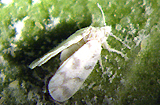Sweet Potato Pest Management
Written 2014
Sweet Potato’s Insect Pests
You may be familiar with sweet potatoes among Thanksgiving dinner tables, but these crops thrive in Florida’s hot summers. The colorful potatoes are grown throughout the state and are good sources of vitamins A and C. Unfortunately, the potatoes also have unwanted pests.
Here are some pests farmers should become familiar with, so they can keep their sweet potatoes prosperous.
Insect Pests
Banded Cucumber Beetle
The banded cucumber beetle is a vegetable pest found throughout Florida. Although these beetles damage all parts of the plant, the larvae feeding on the sweet potato’s roots cause the most harm.
Around planting time, add granular insecticides over the vegetable row to prevent damage. Insecticides can be used to avoid root damage as well.
Sweetpotato Weevil
The sweetpotato weevil is Florida’s, and the world’s, most serious sweet potato pest. The small, ant-like beetles hatch larvae that dig into the potato’s tubers, or underground stems, and fill crevices with fecal matter. This creates bacteria and causes decay.
Pests can be controlled by using insecticides, separating infected crops, throwing away host plants, and using postharvest treatments. To avoid an infestation, be sure to use only certified transplants from weevil-free areas.
Silverleaf Whitefly
The silverleaf whitefly (also known as the sweetpotato whitefly) is a common foliar pest found in sweet potatoes. These pests feed on plants and remove nutrients, causing poor growth, defoliation, and sometimes death.
Field hygiene techniques, such as not growing crops for two months in the summer and destroying infected crops, can manage whitefly populations. Avoid using broad-spectrum insecticides—they can kill the whitefly’s natural predators.
Wireworms
Like the sweetpotato weevil, the wireworm larvae destroy sweet potato roots. The firm-bodied larvae can live in the soil up to four years, and they eat tiny, circular holes in the roots.
It's best to plant sweet potatoes early in the season because wireworms are dormant throughout the spring. Other than using a broadcast soil insecticide, deep plowing can kill larvae as well.
Adapted and excerpted from:
J.L., Capinera, “Featured Creature: banded cucumber beetle” (EENY-93), UF/IFAS Entomology & Nematology Department (rev. 02/2014).
J.L., Capinera, “Featured Creature: sweetpotato weevil” (EENY-27), UF/IFAS Entomology & Nematology Department (rev. 06/ 2009).
G., Zehnder, “A Sweet Potato Grower’s Guide to Insect Pest Management” (ANR-1104), Alabama Cooperative Extension System (Accessed 06/2014).
Mark A. Mossler and O. Norman Nesheim, “Florida Crop/Pest Management Profile: Eggplant” (CIR1264), UF/IFAS Department of Agronomy (rev. 09/2012).
S.E., Webb, “Insect Management for Sweet Potatoes” (ENY173), UF/IFAS Entomology and Nematology Department (rev. 06/ 2013).

Related Sites & Articles
- Hot Topics
- Potato Pest Management
- UF/IFAS Publications
- Sweet Potato Pest Insects
- UF/IFAS Sites
- Sweetpotato Production in Florida

